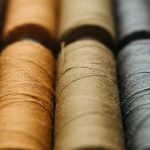Yes, you can wash polypropylene fabric, and it’s pretty easy to care for. Use cold water and a gentle cycle if you’re machine washing, or hand wash with mild detergent and lukewarm water. Avoid bleach, fabric softeners, and high heat to keep the fibers strong and colors bright. Air drying is best to prevent damage. If you want to learn the best ways to keep your polypropylene gear looking fresh and lasting longer, there are some handy tips to explore.
Table of Contents
Key Takeaways
- Polypropylene fabric is washable and resists stains and moisture, making it easy to clean.
- Use mild detergent and cold water on a gentle cycle or hand wash with lukewarm water (30°C-40°C).
- Avoid bleach, fabric softeners, and high temperatures to maintain fabric integrity and durability.
- Air drying is preferred; avoid high heat and do not wring the fabric to prevent damage.
- Treat stains promptly with mild detergent or diluted vinegar, and store fabric in a cool, dry place away from sunlight.
Understanding Polypropylene Fabric and Its Properties
Polypropylene fabric stands out for its unique combination of lightweight durability and moisture resistance. When you choose this fabric, you benefit from its excellent strength-to-weight ratio, making it ideal for activewear and outdoor gear.
It doesn’t absorb water like cotton, so it dries quickly and resists mildew. You’ll also find it has good chemical resistance, which helps it withstand exposure to oils and solvents. Plus, it’s naturally stain-resistant, so spills won’t soak in easily.
However, polypropylene isn’t very heat-tolerant; high temperatures can cause it to melt or warp. Knowing these properties helps you understand why it’s popular in specific applications and why you should handle it carefully to maintain its performance and appearance over time.
Can You Wash Polypropylene Fabric?
How should you care for polypropylene fabric when it gets dirty?
Yes, you can wash polypropylene fabric, and it’s actually quite easy to maintain. This material is resistant to stains and dries quickly, making it ideal for regular washing.
You should avoid harsh chemicals and high temperatures, as extreme heat can damage the fibers. Hand washing with mild detergent in cool or lukewarm water is a safe option, especially for delicate items.
While polypropylene is durable, it’s best to steer clear of bleach and fabric softeners, which can degrade the fabric’s properties.
After washing, air drying is preferable to keep the fabric’s integrity intact.
Best Practices for Machine Washing Polypropylene
Although polypropylene fabric is durable, you should take certain precautions when machine washing it to maintain its quality. Use cold water and a gentle cycle to prevent damage. Avoid bleach and fabric softeners, which can degrade the fibers. Wash polypropylene items separately or with similar fabrics to reduce friction. Finally, air dry or tumble dry on low heat to avoid melting or warping.
| Best Practice | Reason |
|---|---|
| Use cold water | Prevents fabric damage |
| Select gentle cycle | Minimizes wear and tear |
| Avoid bleach | Protects fiber integrity |
| Wash with similar fabrics | Reduces friction and pilling |
| Air dry or low heat | Prevents melting or warping |
How to Hand Wash Polypropylene Fabric Safely
When you hand wash polypropylene fabric, choosing a gentle detergent is key to protecting its fibers.
Make sure the water is lukewarm, as hot water can damage the material.
These simple steps help keep your fabric in great shape without harsh wear.
Gentle Detergent Selection
Since polypropylene fabric is sensitive to harsh chemicals, you should choose a gentle detergent to preserve its durability and texture.
Avoid detergents with bleach, fabric softeners, or strong enzymes, as these can break down the fibers. Instead, opt for mild, pH-neutral detergents designed for delicate fabrics. These will clean your polypropylene without causing damage or fading.
When mixing the detergent in water, use only a small amount to prevent residue buildup. If you want extra caution, test the detergent on a hidden area first to verify it doesn’t affect the color or feel.
Using the right detergent helps maintain the fabric’s strength and appearance, making your polypropylene items last longer and look better after each wash.
Proper Water Temperature
Choosing the right detergent is just one part of caring for your polypropylene fabric. You also need to pay close attention to water temperature when hand washing.
Use lukewarm or cool water—ideally between 30°C to 40°C (86°F to 104°F). Hot water can weaken polypropylene fibers, causing them to lose strength and shape over time. Avoid temperatures above 50°C (122°F) to prevent damage.
Lukewarm water helps dissolve detergent effectively without stressing the fabric. When you fill your basin or sink, test the water to verify it’s comfortably warm, not hot. Washing at the right temperature preserves the fabric’s durability and performance, keeping it looking and feeling good longer.
Always rinse your polypropylene garment in cool water to lock in cleanliness and maintain fabric integrity.
Drying Techniques That Protect Polypropylene
Proper drying techniques play an essential role in maintaining the durability and appearance of polypropylene fabric. You should avoid high heat, as it can warp or melt the fibers. Instead, air drying is your safest bet. If you use a dryer, set it to low or no heat. Also, avoid wringing the fabric, which can damage the fibers.
| Drying Method | Heat Level | Effect on Polypropylene |
|---|---|---|
| Air Dry | None | Safest, preserves shape |
| Tumble Dry | Low/No Heat | Acceptable, but monitor closely |
| Wringing | N/A | Damages fibers, avoid it |
Following these tips will help you keep your polypropylene fabric looking and feeling great longer.
Stain Removal Tips for Polypropylene Fabric
How do you tackle stains on polypropylene fabric without causing damage?
First, act quickly—blot the stain gently with a clean cloth to absorb excess liquid. Avoid rubbing, as it can push the stain deeper.
Act fast by blotting stains gently with a clean cloth—rubbing only drives the stain deeper.
Use a mild detergent mixed with warm water and apply it directly to the stain with a soft brush or cloth. Let it sit for a few minutes, then rinse thoroughly with cold water.
For tougher stains, try a diluted solution of white vinegar or baking soda paste, but always test on a hidden area first.
Avoid bleach or harsh chemicals, as they can weaken the fabric.
Finally, air dry the item away from direct heat to prevent any damage.
Following these steps will keep your polypropylene fabric looking fresh and clean.
Extending the Lifespan of Polypropylene Items
To keep your polypropylene items lasting longer, you’ll want to follow proper cleaning techniques that avoid damage.
Handling them gently and storing them in a cool, dry place can prevent wear and tear.
Let’s explore how these small steps can make a big difference.
Proper Cleaning Techniques
Maintaining polypropylene fabric’s durability largely depends on the way you clean it. To keep your items in top shape, avoid hot water and harsh detergents, which can break down fibers. Instead, use cold or lukewarm water with mild soap. Gently hand wash or use the delicate cycle on your machine. Avoid bleach and fabric softeners, as they damage the fabric’s properties. After washing, air dry your polypropylene items by laying them flat or hanging them up—skip the dryer to prevent shrinking or warping.
| Cleaning Step | Recommended Approach |
|---|---|
| Water Temperature | Cold or lukewarm |
| Detergent | Mild, gentle soap |
| Washing Method | Hand wash or delicate cycle |
| Bleach | Avoid |
| Drying | Air dry, avoid dryer |
Storage and Handling Tips
Although polypropylene fabric is known for its durability, proper storage and handling play an essential role in extending the life of your items.
To keep your polypropylene pieces in top shape, avoid exposing them to harsh conditions or rough treatment. Here are some tips to help you care for them effectively:
- Store items in a cool, dry place away from direct sunlight to prevent fading and degradation.
- Avoid folding tightly; instead, roll or hang to maintain shape and avoid creases.
- Keep away from sharp objects that can cause snags or tears.
- Clean items before storing to prevent stains from setting and attracting pests.
- Use breathable storage bags to allow air circulation and reduce moisture buildup.
Following these tips guarantees your polypropylene fabric stays durable and looks great longer.
Frequently Asked Questions
Is Polypropylene Fabric Environmentally Friendly?
You might find polypropylene fabric less eco-friendly since it’s petroleum-based and non-biodegradable. However, you can recycle it and reduce waste by reusing items made from it. Choose alternatives if you want greener options.
Can Polypropylene Fabric Be Recycled?
Did you know only about 14% of polypropylene is recycled globally? You can recycle polypropylene fabric, but it depends on local facilities. Check with your recycler to verify they accept it, helping reduce plastic waste.
How Does Polypropylene Fabric Compare to Polyester?
You’ll find polypropylene lighter and more water-resistant than polyester, but polyester feels softer and handles heat better. Both dry quickly, but polypropylene’s moisture-wicking suits activewear, while polyester excels in durability and color retention.
Is Polypropylene Fabric Suitable for Outdoor Use?
Think of polypropylene as your outdoor shield, tough and weather-resistant. You’ll find it perfect for outdoor use since it resists moisture, mildew, and UV rays, keeping your gear durable through sun, rain, and wind.
Does Polypropylene Fabric Cause Skin Irritation?
You typically won’t experience skin irritation from polypropylene fabric since it’s hypoallergenic and moisture-wicking. However, if your skin’s sensitive or the fabric’s rough, you might feel some discomfort or itching occasionally.
- Where to Buy Wholesale Burnout Fabric: A Guide for Businesses - June 20, 2025
- An Introduction to Burnout Satin and Its Lustrous Appeal - June 20, 2025
- The Unique Properties of Burnout Cotton Fabric - June 20, 2025







